The question “Can dogs get cancer?” weighs heavily on the minds of many pet owners, especially those with Golden Retrievers. Unfortunately, the answer is yes– dogs can and do get cancer at alarming rates. For Golden Retriever owners, this reality is particularly concerning, as this beloved breed faces one of the highest cancer incidences among all dog breeds. Understanding whether do dogs get cancer, recognizing early warning signs, and knowing prevention strategies can make a life-saving difference for your furry companion.
This comprehensive guide will explore everything you need to know about cancer in Golden Retrievers, from understanding risk factors to implementing preventive measures that could extend your dog’s healthy years.
Contents
- 1 Understanding Cancer in Dogs: The Sobering Reality
- 2 Common Cancer Types in Golden Retrievers
- 3 Recognizing Early Signs: Can You Spot Cancer Before It’s Too Late?
- 4 Age and Cancer Risk: When Do Dogs Get Cancer Most Frequently?
- 5 Environmental and Lifestyle Factors: Do Dogs Get Cancer from Their Surroundings?
- 6 Prevention Strategies: Can You Prevent Dogs from Getting Cancer?
- 7 Genetic Testing and Breeding Considerations
- 8 Early Detection Through Regular Monitoring
- 9 Treatment Options and Prognosis Factors
- 10 Prognosis and Quality of Life Considerations
- 10.1 Factors Affecting Outcomes.
- 10.2 Making Difficult Decisions.
- 10.3 Can dogs get cancer at any age?
- 10.4 Do dogs get cancer more often than other pets?
- 10.5 What are the most common signs that my Golden Retriever might have cancer?
- 10.6 How can I tell if a lump on my Golden Retriever is cancerous?
- 10.7 Are certain Golden Retriever bloodlines more prone to cancer?
- 10.8 Can diet prevent cancer in Golden Retrievers?
- 10.9 What should I do if I suspect my Golden Retriever has cancer?
- 10.10 How expensive is cancer treatment for Golden Retrievers?
- 11 Final Thoughts
Understanding Cancer in Dogs: The Sobering Reality
Can dogs get cancer? Absolutely, and the statistics are more startling than many owners realize. According to veterinary oncologists, approximately one in four dogs will develop cancer during their lifetime, with the risk increasing dramatically as dogs age. For Golden Retrievers specifically, the numbers are even more alarming– studies suggest that up to 60% of Golden Retrievers will face a cancer diagnosis at some point in their lives.
Do dogs get cancer at the same rate as humans? In many ways, yes. Dogs develop many of the same cancer types that affect humans, including lymphoma, osteosarcoma, hemangiosarcoma, and various carcinomas. The similarity between canine and human cancers has made dogs valuable partners in cancer research, helping advance treatments for both species.
Why Golden Retrievers Are Particularly Susceptible
Golden Retrievers face elevated cancer risks due to several factors:
Genetic Predisposition:
- Selective breeding has concentrated certain genetic traits
- Hereditary factors contribute to cancer susceptibility
- Specific genetic mutations are more common in the breed
- Family history significantly impacts individual risk
Breed-Specific Cancer Types:
- Hemangiosarcoma affects the spleen and heart
- Lymphoma impacts the lymphatic system
- Osteosarcoma targets bones, especially in the legs
- Golden Retriever cancer symptoms often relate to these specific types
Common Cancer Types in Golden Retrievers
Understanding the specific cancers that commonly affect Golden Retrievers helps owners recognize signs of cancer in dogs more effectively.
Hemangiosarcoma: The Silent Killer
Hemangiosarcoma is particularly devastating because it often shows no dog cancer symptoms until advanced stages. This aggressive cancer affects blood vessels and commonly develops in the spleen, heart, or liver.
Early Warning Signs:
- Sudden weakness or collapse
- Pale gums
- Rapid breathing
- Abdominal swelling
- Loss of appetite
Risk Factors:
- Age (most common in dogs 8+ years).
- Male dogs have a slightly higher risk.
- Previous trauma to affected areas.
- Genetic predisposition in Golden Retrievers.
Lymphoma: Affecting the Immune System
Lymphoma is one of the most treatable cancers when caught early, making recognition of the signs and symptoms of cancer in dogs crucial.
Visible Symptoms:
- Swollen lymph nodes (under the jaw, armpits, groin).
- Loss of appetite and weight loss.
- Increased thirst and urination.
- Difficulty breathing if chest lymph nodes are involved.
Treatment Response:
- High response rates to chemotherapy.
- Many dogs achieve remission.
- Quality of life can be maintained during treatment.
- Early detection significantly improves outcomes.
Osteosarcoma: Bone Cancer Challenges.
Osteosarcoma primarily affects the long bones of the legs and can cause significant pain and mobility issues.
Key Symptoms:
- Lameness or limping that doesn’t improve.
- Swelling around affected bones.
- Pain when touched.
- Reluctance to exercise or play.
- The final stages of osteosarcoma in dogs include severe mobility limitations.
Mast Cell Tumors: Skin Cancer Concerns
These tumors can appear anywhere on the skin and vary dramatically in appearance and behavior.
Identification Features:
- Raised bumps or flat patches on skin.
- May be pink, red, or flesh-colored.
- Can change size quickly.
- Often itchy, causing excessive scratching.
- What does cancer look like on a dog varies significantly with mast cell tumors.
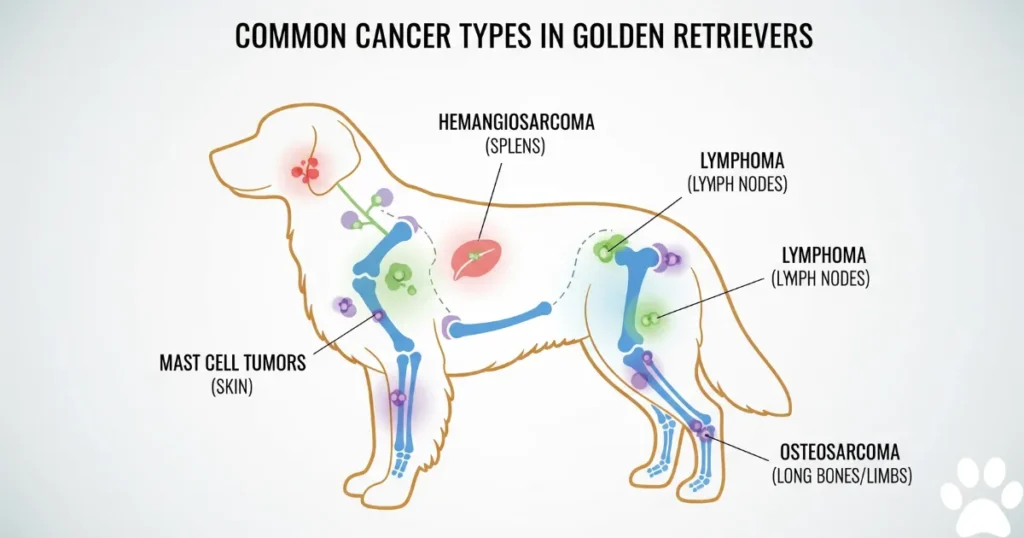
Recognizing Early Signs: Can You Spot Cancer Before It’s Too Late?
Early detection dramatically improves treatment outcomes, making it essential for Golden Retriever owners to understand how to tell if their dog has cancer.
Physical Signs to Monitor
External Changes:
- Unusual lumps or bumps anywhere on the body.
- Changes in existing moles or skin patches.
- Sores that don’t heal within 2-3 weeks.
- Cancer sores on dogs may appear ulcerated or infected.
- Swelling in the face, legs, or abdomen.
Internal Symptoms:
- Persistent coughing or difficulty breathing.
- Changes in bathroom habits.
- Blood in urine or stool.
- Vomiting or diarrhea lasting more than 24 hours.
- Difficulty swallowing or eating.
Behavioral Changes That Signal Problems
Energy and Activity Levels:
- Sudden decrease in energy or stamina.
- Reluctance to exercise or play.
- Sleeping more than usual.
- Hiding or seeking isolation.
- Changes in favorite activities.
Appetite and Eating Patterns:
- Loss of interest in food or treats.
- Difficulty chewing or swallowing.
- Drooling excessively during meals.
- Weight loss despite normal appetite.
- Increased thirst and urination.
Pain Indicators in Golden Retrievers
Subtle Pain Signs:
- Changes in posture or gait.
- Reluctance to jump or climb stairs.
- Decreased tail wagging.
- Less interaction with family members.
- Restlessness or inability to get comfortable.

Age and Cancer Risk: When Do Dogs Get Cancer Most Frequently?
Understanding age-related cancer risks helps Golden Retriever owners know when to be most vigilant about dog cancer symptoms.
Puppy and Young Adult Risks (Under 3 Years)
While cancer is less common in young dogs, certain types can affect puppies and young adults:
- Lymphoma can occur at any age.
- Some bone cancers develop in rapidly growing puppies.
- Certain genetic cancers may manifest early.
- Environmental factors can trigger early-onset cancer.
Middle Age Vulnerability (3-7 Years)
This age group faces moderate cancer risk with increasing vigilance needed:
- Regular veterinary checkups become more important.
- Signs of cancer in dogs may be subtle.
- Reproductive cancers are more common in unspayed females.
- Lifestyle factors begin to show cumulative effects.
Senior Dog High-Risk Period (7+ Years)
Golden Retrievers over seven years face the highest cancer risk:
- Age is the single biggest cancer risk factor.
- Multiple cancer types become more likely.
- How do you know if your dog has cancer becomes critical knowledge.
- More frequent veterinary monitoring is essential.
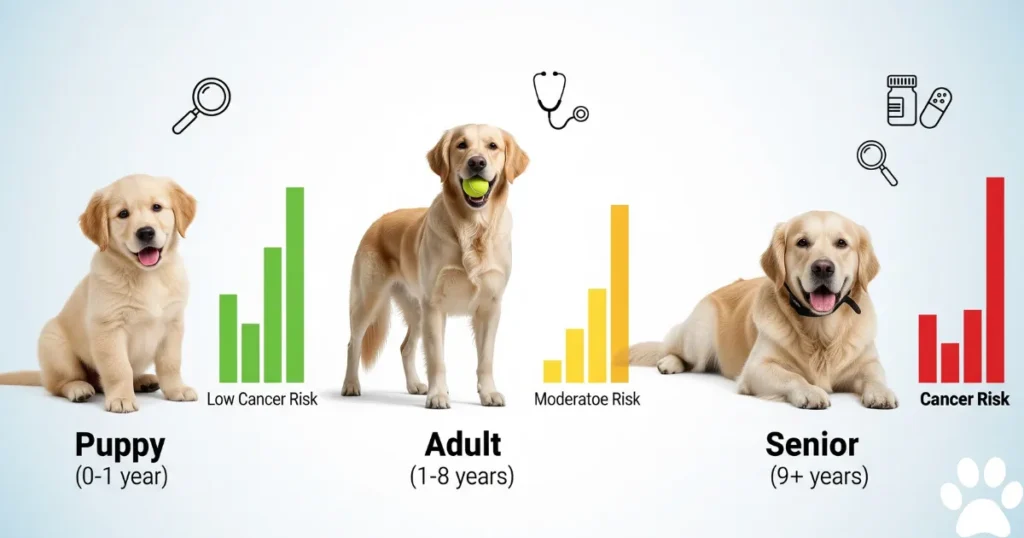
Environmental and Lifestyle Factors: Do Dogs Get Cancer from Their Surroundings?
Environmental factors significantly influence whether can dogs get cancer becomes a reality for your Golden Retriever.
Chemical Exposures to Avoid
Household Chemicals:
- Cleaning products with harsh chemicals.
- Pesticides and herbicides on lawns.
- Flea and tick treatments with toxic ingredients.
- Air fresheners and scented candles.
- Second-hand smoke from cigarettes.
Outdoor Environmental Hazards:
- Industrial pollution and smog.
- Contaminated water sources.
- Treated wood and pressure-treated materials.
- Asbestos in older buildings.
- Heavy metals in soil or water.
Dietary Factors and Cancer Risk
Foods That May Increase Risk:
- Processed foods with artificial preservatives.
- Poor-quality commercial dog foods.
- Foods high in nitrates and nitrites.
- Excessive treats with artificial colors.
- Contaminated or recalled pet foods.
Cancer-Fighting Nutrition:
- High-quality protein sources.
- Antioxidant-rich fruits and vegetables.
- Omega-3 fatty acids from fish.
- Fresh, whole food ingredients.
- Limited processed food consumption.
Prevention Strategies: Can You Prevent Dogs from Getting Cancer?
While you can not completely prevent cancer, many strategies can significantly reduce your Golden Retriever’s risk.
Nutritional Prevention Approaches
Optimal Diet Components:
- Premium dog food with natural ingredients.
- Fresh vegetables like broccoli and carrots.
- Blueberries and other antioxidant-rich fruits.
- Fish oil supplements for omega-3 fatty acids.
- Limited treats and table scraps.
Foods and Supplements to Consider:
- Turmeric for its anti-inflammatory properties.
- Green tea extract (in dog-safe amounts).
- Probiotics for immune system support.
- Vitamin E and C supplementation.
- Consultation with a veterinary nutritionist.
Exercise and Weight Management
Activity Benefits:
- Regular exercise boosts immune function.
- Maintains a healthy weight, reducing cancer risk.
- Improves circulation and lymphatic drainage.
- Provides stress relief and mental stimulation.
- Strengthens overall health and resilience.
Weight Control Importance:
- Obesity increases cancer risk significantly.
- Extra weight stresses organs and systems.
- Fat cells can produce inflammatory compounds.
- Overweight dogs face surgical risks if cancer develops.
- Maintaining an ideal weight improves treatment outcomes.
Environmental Safety Measures
Home Environment:
- Use natural cleaning products when possible.
- Avoid chemical lawn treatments.
- Ensure good ventilation in living spaces.
- Filter drinking water if necessary.
- Choose natural pest control methods.
Outdoor Safety:
- Limit exposure to heavily polluted areas.
- Avoid walking on recently treated lawns.
- Provide shade during peak sun hours.
- Use pet-safe ice melts in winter.
- Be cautious around construction or industrial sites.
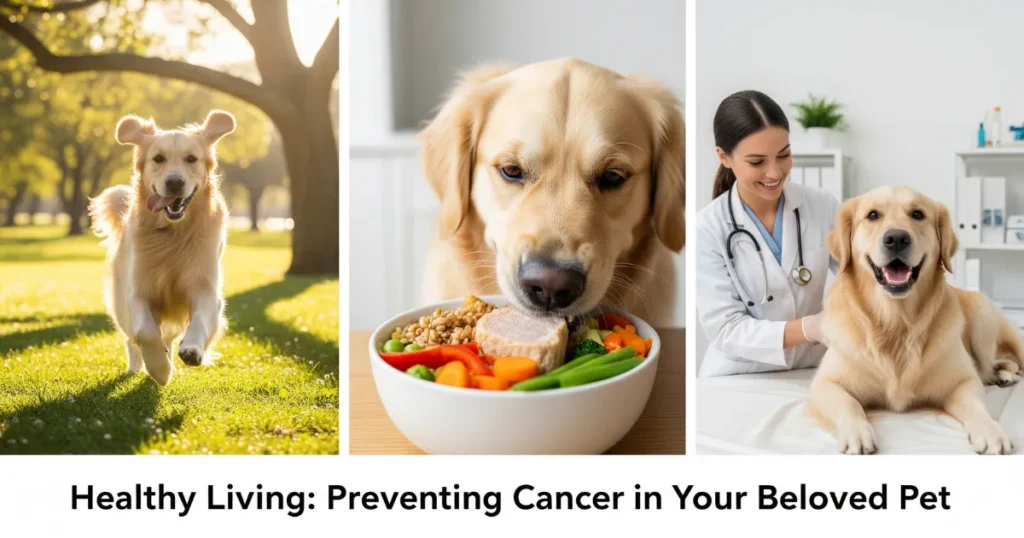
Genetic Testing and Breeding Considerations
For Golden Retriever owners considering breeding or wanting to understand their dog’s cancer risk, genetic testing offers valuable insights.
Available Genetic Tests
Cancer-Related Genetic Markers:
- Tests for specific cancer predispositions.
- Hereditary cancer syndrome screening.
- DNA analysis for breed-specific risks.
- Family history documentation.
- Breeding decision guidance.
Benefits of Genetic Testing:
- Early identification of high-risk dogs.
- Informed breeding decisions.
- Customized prevention strategies.
- Better veterinary monitoring plans.
- Peace of mind for owners.
Early Detection Through Regular Monitoring
Do dogs get cancer? Consistent monitoring significantly improves the chances of catching signs and symptoms of cancer in dogs early.
Monthly Home Examinations
Physical Examination Routine:
- Run hands over entire body, feeling for lumps.
- Check mouth and gums for unusual growths.
- Examine eyes for changes or discharge.
- Feel the lymph nodes for swelling.
- Monitor breathing patterns and effort.
Record Keeping:
- Document any new findings.
- Photograph unusual growths or changes.
- Track weight and appetite changes.
- Note behavioral modifications.
- Share findings with the veterinarian.
Professional Veterinary Care
Routine Checkup Frequency:
- Every 6 months for dogs over 7 years.
- Annual exams for younger adults.
- More frequent visits if a cancer history exists.
- Discuss canine cancer symptoms with a veterinarian.
- Request thorough physical examinations.
Diagnostic Screening Options:
- Blood work to detect abnormalities.
- Imaging studies for internal organ assessment.
- Fine needle aspirates of suspicious lumps.
- Biopsy procedures when indicated.
- Advanced cancer screening protocols.
Treatment Options and Prognosis Factors
Understanding treatment possibilities helps owners make informed decisions if their Golden Retriever develops cancer.
Surgical Interventions
Common Surgical Procedures:
- Dog tumor removal with clean margins.
- Lymph node biopsy and removal.
- Amputation for bone cancers.
- Spleen removal for hemangiosarcoma.
- Reconstructive procedures when possible.
Surgery Success Factors:
- Early detection and intervention.
- Complete tumor removal.
- Dog’s overall health status.
- Age and recovery ability.
- Post-surgical care quality.
Medical Treatment Approaches
Chemotherapy Considerations:
- Generally well-tolerated in dogs.
- Different protocols for various cancer types.
- Side effects are typically milder than in humans.
- Quality of life is maintained during treatment.
- Cancer in canines responds differently from human cancer.
Radiation Therapy:
- Effective for certain tumor types.
- Often combined with surgery.
- Requires specialized veterinary facilities.
- May extend survival and improve quality of life.
- Careful consideration of benefits vs. risks.
Palliative and Supportive Care
Comfort-Focused Treatments:
- Pain management protocols.
- Anti-nausea medications.
- Appetite stimulants.
- Nutritional support.
- Quality of life assessments.
Alternative and Complementary Therapies:
- Acupuncture for pain relief.
- Herbal supplements (under veterinary guidance).
- Massage therapy for comfort.
- Physical therapy for mobility.
- Emotional support and bonding time.
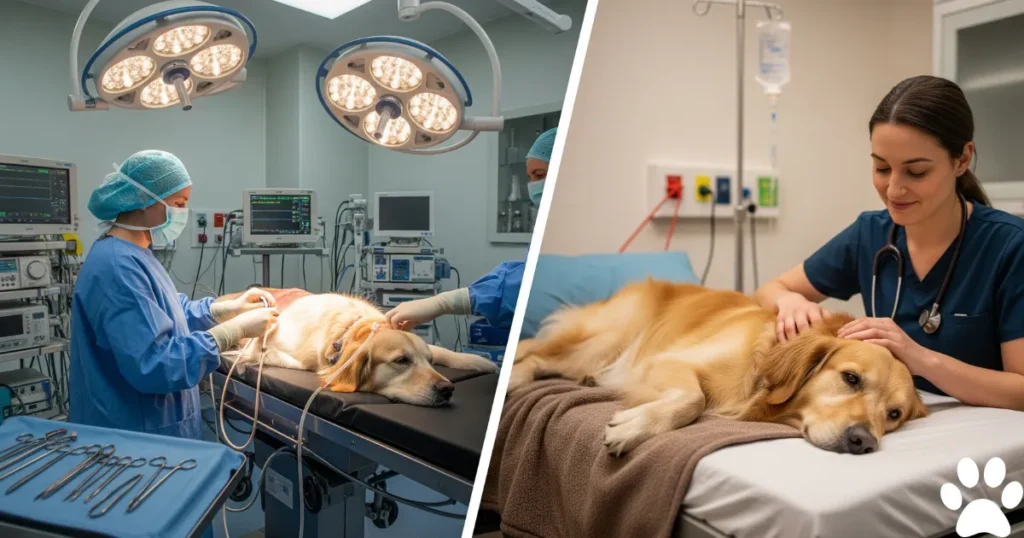
Prognosis and Quality of Life Considerations
Cancer prognosis varies dramatically based on multiple factors specific to each Golden Retriever.
Factors Affecting Outcomes.
Medical Factors:
- Cancer type and stage at diagnosis.
- Age and overall health of the dog.
- Response to initial treatment.
- Presence of metastasis.
- Access to specialized veterinary care.
Quality of Life Indicators:
- Ability to enjoy normal activities.
- Appetite and interest in food.
- Interaction with family members.
- Pain levels and comfort.
- Will a dog with lymphoma dies naturally depends on individual circumstances.
Making Difficult Decisions.
Treatment Decision Factors:
- Expected survival time with treatment.
- Quality of life during treatment.
- Financial considerations.
- Family’s emotional capacity.
- Dog’s personality and stress tolerance.
End-of-Life Planning:
- Discussing options with the veterinary team.
- Understanding symptoms of the final stages of canine lymphoma.
- Planning for comfort care.
- Considering euthanasia timing.
- Emotional support for family members.

Can dogs get cancer at any age?
Yes, can dogs get cancer at virtually any age, though the risk increases significantly with age. While cancer is less common in puppies and young dogs, certain types, like lymphoma, can affect dogs of all ages. Golden Retrievers face elevated risk starting around age 5, with the highest incidence occurring after age 7-8 years.
Do dogs get cancer more often than other pets?
Do dogs get cancer more frequently than cats or other pets? Yes, dogs have higher overall cancer rates than most other companion animals. Large breed dogs like Golden Retrievers face particularly elevated risks compared to smaller breeds and other pet species, partly due to genetic factors and longer lifespans.
What are the most common signs that my Golden Retriever might have cancer?
The most common signs of cancer in dogs include unusual lumps or bumps, persistent sores, changes in appetite or weight, difficulty breathing, lameness, and behavioral changes like decreased energy. Golden Retrievers specifically should be monitored for swollen lymph nodes, abdominal swelling, and sudden weakness, which could indicate breed-specific cancers.
How can I tell if a lump on my Golden Retriever is cancerous?
Visual examination alone can not determine if a dog tumor is cancerous. Any new lump should be evaluated by a veterinarian who can perform diagnostic tests like fine needle aspiration or biopsy. However, warning signs include rapid growth, irregular shape, firm attachment to surrounding tissues, and ulceration.
Are certain Golden Retriever bloodlines more prone to cancer?
Yes, genetics plays a significant role in cancer susceptibility. Some Golden Retriever bloodlines have higher cancer incidences due to hereditary factors. Responsible breeders often conduct genetic testing and maintain health records to identify and reduce cancer risks in their breeding programs.
Can diet prevent cancer in Golden Retrievers?
While diet can not completely prevent cancer, proper nutrition significantly reduces risk. High-quality diets rich in antioxidants, omega-3 fatty acids, and natural ingredients support immune function. Avoiding processed foods, artificial preservatives, and maintaining a healthy weight are important preventive measures.
What should I do if I suspect my Golden Retriever has cancer?
If you notice potential dog cancer symptoms, schedule a veterinary appointment immediately. Early detection dramatically improves treatment outcomes. Document any changes you’ve observed, including photos of visible abnormalities, and be prepared to discuss your dog’s symptoms, behavior changes, and timeline of developments.
How expensive is cancer treatment for Golden Retrievers?
Cancer treatment costs vary widely depending on cancer type, stage, and chosen treatments. Basic diagnostic workups may cost $500-2000, while comprehensive treatment, including surgery, chemotherapy, or radiation, can range from $3000-15000 or more. Pet insurance and payment plans may help manage expenses.
Final Thoughts
The question “can dogs get cancer?” unfortunately has a definitive yes answer, particularly for Golden Retriever owners who face higher statistical risks than most other breeds. However, knowledge is power, and understanding that do dogs get cancer at significant rates empowers you to take proactive steps that could save your beloved companion’s life.
Throughout this comprehensive guide, we’ve explored the sobering reality that Golden Retrievers have up to a 60% lifetime cancer risk, but we’ve also highlighted the many ways you can stack the odds in your dog’s favor. From recognizing early signs of cancer in dogs and dog cancer symptoms to implementing prevention strategies through proper nutrition, regular exercise, and environmental safety measures, you now have the tools to be your Golden Retriever’s best health advocate.
Remember that early detection remains your most powerful weapon against cancer. Monthly home examinations, regular veterinary checkups, and staying alert to changes in your dog’s behavior or physical condition can mean the difference between a treatable diagnosis and a terminal one. Whether you’re monitoring for what does cancer look like on a dog, watching for signs and symptoms of cancer in dogs, or simply maintaining preventive care, your vigilance matters immensely.
While the statistics about cancer in canines may seem overwhelming, take heart in knowing that veterinary oncology has made tremendous advances in recent years. Many Golden Retrievers with cancer diagnoses go on to live quality, happy lives with proper treatment and care. The key is catching problems early, working with experienced veterinary professionals, and never hesitating to seek help when something doesn’t seem right.
Your Golden Retriever depends on you to be their voice and their protector. By staying informed about canine cancer symptoms, maintaining preventive care routines, and building a strong relationship with your veterinary team, you’re giving your furry family member the best possible chance at a long, healthy life. The love and attention you provide today could be the difference that matters most when it comes to cancer prevention and early detection.
Dr. Nabeel A.
Hi, I’m Dr. Nabeel Akram – a farm management professional by trade and a passionate Golden Retriever enthusiast at heart. With years of experience in animal science and livestock care, I’ve built a career around understanding animals—how they live, thrive, and bring value to our lives. This blog is a personal project born from that same passion, focusing on one of the most loyal and lovable breeds out there: the Golden Retriever. Whether I’m managing farm operations or sharing insights on canine health, behavior, and care, it all ties back to one core belief—animals deserve thoughtful, informed, and compassionate attention. Welcome to a space where professional expertise meets genuine love for dogs.
Facebook |
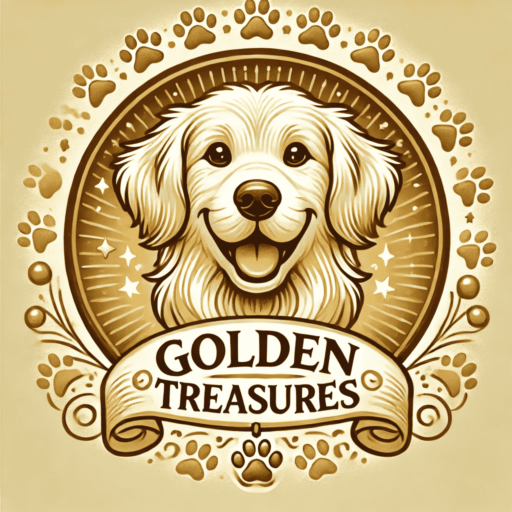
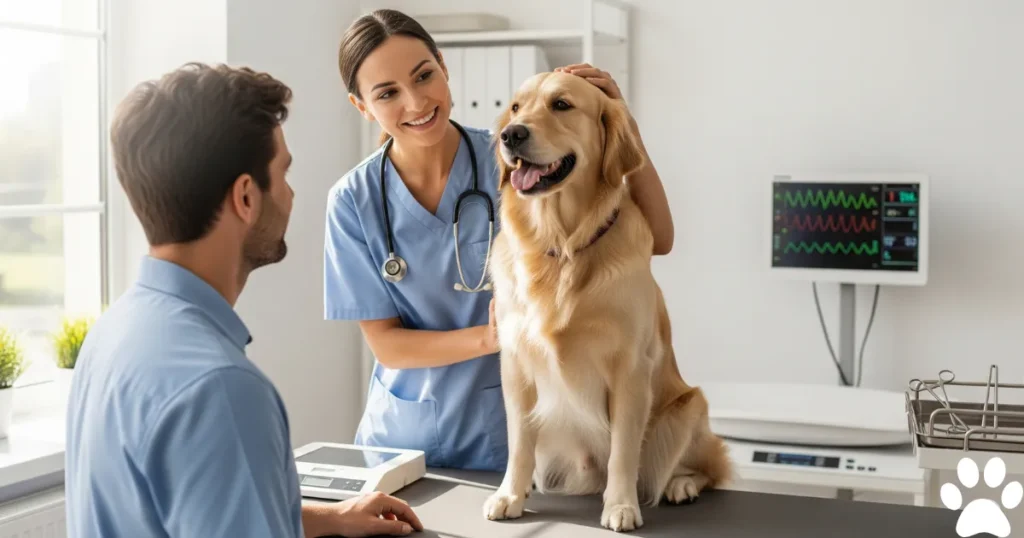
Links will be automatically removed from comments.